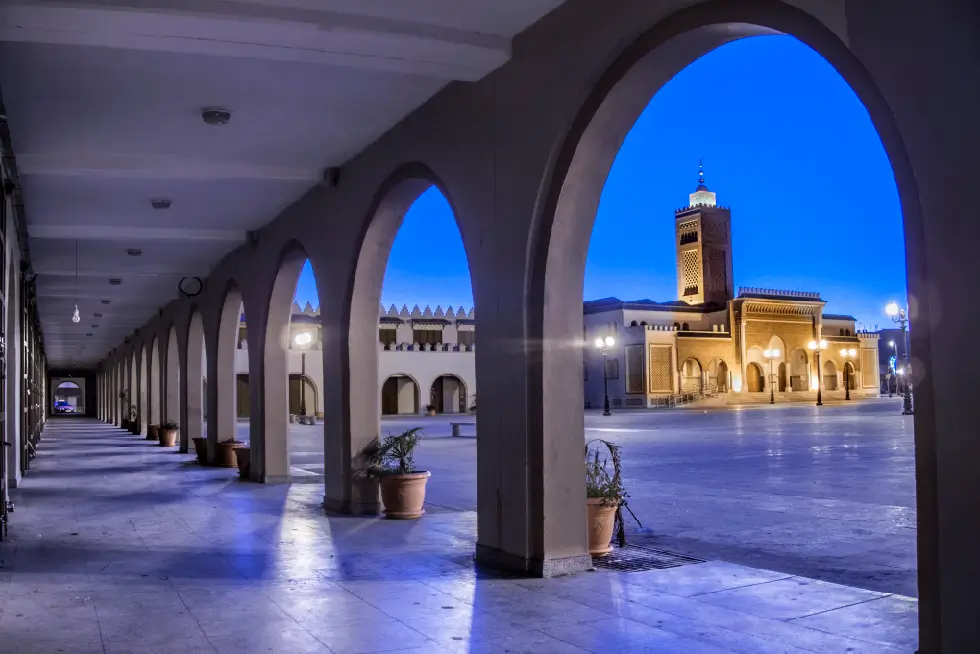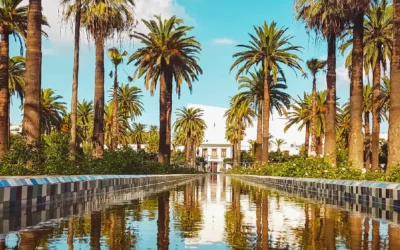Oujda City: The Heart of the Orient In Morocco

Table of Contents:
Introduction to Oujda City
Oujda city is the capital of the Oriental region of Morocco, a jewel in the northeastern, This city is uniquely positioned near the border of Algeria, just 15 kilometers away, and nestled in the southern skirts of the Beni-Znassen Mountains.
It’s also a mere 55 kilometers from the Mediterranean Sea coast. This strategic location makes Oujda a cultural crossroads, where Maghrebi and Amazigh influences weave into a rich, distinctive tapestry unique to Morocco.
The city’s role as a cultural bridge between the Arab and Berber worlds enhances its allure. Here, visitors can witness a unique blend of cultural elements, reflected in Oujda’s architecture, cuisine, and everyday life.
This blend creates a captivating experience for those keen on exploring the diverse cultural landscape of North Africa.
Oujda Discovery Tour
Oujda, a blend of the old and the new, invites travelers to explore and discover its diverse and fascinating attractions. Here are some of the popular places to explore:
1. Medina
Step into the heartbeat of Oujda’s history at the Medina. A treasure trove of culture and history, it’s an essential stop for every visitor.
2. Parc Lalla Aicha
Escape into serenity at this beloved park. It’s a haven for relaxation and leisure, cherished by locals and tourists alike.
3. Grande Mosquée
Marvel at this architectural masterpiece. As a central religious and historical landmark, it’s a testament to Oujda’s spiritual richness.
4. Le Souk de Oujda
Immerse yourself in the vibrant local culture at this bustling market. It’s a perfect spot to shop and experience the city’s lively spirit.
5. Parc Lalla Meryem
Discover a refreshing natural oasis right in the city. This park offers a peaceful retreat and a glimpse of local life.
6. Grand Synagogue of Oujda
Explore the beautifully restored synagogue, symbolizing the city’s diverse Jewish heritage.
7. Mosque of Omar Bin Abdul Aziz and Mohammed Vi Mosque
These stunning mosques are not just spiritual landmarks but also architectural marvels.
8. Radwan Mosque
Add another layer to your religious exploration of Oujda with a visit to this significant mosque.
9. Dar Sebti Palace
Now the Museum of Oujda, this restored palace offers a window into the city’s architectural and cultural past.
10. Sidi Yahya Shrine
Pay respects at the shrine of Sidi Yahya, a revered Islamic scholar, to understand the city’s spiritual depth.
11. Complexe le Tropical
Experience Oujda’s contemporary side at this modern hotspot, blending the new with the traditional.
12. Yac Shop
A unique shopping experience awaits here, where traditional meets modern in a creative fusion.
Oujda Accessibility And Transportation
Whether you’re flying in from afar or journeying within Morocco, here’s what you need to know:
1. Air Travel
Angads Airport stands as Oujda’s gateway to the world, with international flights to cities like Lisbon, Brussels, Madrid, Marseille, and Paris. It also offers convenient domestic flights to Casablanca, easing travel within Morocco.
2. Train Travel
Experience the scenic routes with Oujda’s train services. Connect from major Moroccan cities like Casablanca (10-hour journey) and Fez (5½-hour journey). However, do note that there’s no train service from Algeria.
3. Road and Taxi Travel
Navigate Oujda’s streets and beyond with ease. The city is accessible from the north, west, and south, but the closed border with Algeria limits eastern access. Grand taxis offer affordable travel to nearby destinations, while the bus station connects you to wider regions like Taza and Fes.
4. Public Transport Efficiency
Oujda’s public transportation system is both modern and efficient, featuring buses and taxis. Taxis, in particular, are a popular choice for their convenience and affordability. However, remember that there are no direct bus services from the airport to the city center.
5. Boat Access
For those seeking adventures on the high seas, boat services are available from Nador and Melilla, each about three to four hours away from Oujda.
Modern Oujda and its Economic Significance
Oujda serves as a pivotal point in regional dynamics. The economic growth of Oujda is partly attributed to nearby coal, lead, and zinc mines. its strategic location has historically made it a crucial hub for cultural and economic exchanges.
Tourism and Education
The tourism sector, Strengthened by the development along the Mediterranean coast, has given new life to Oujda’s economy.
This resurgence has also enhanced the relevance of Oujda’s airport. Furthermore, the local university continues to be a cornerstone of both the economy and the intellectual sphere.
Agriculture
Oujda is positioned in a fertile plain, conducive to agriculture, with olives and grapes being prominent produce. The region also supports the cultivation of cereals, primarily wheat, and the rearing of sheep and goats.
Historical Context
Historically, Oujda has always been a significant trading center. Its geographical position at the crossroads of major routes across Morocco and Algeria has perennially placed it at the center of trade and cultural interactions.
Recent Developments
In terms of recent developments, Oujda has shown a notable proficiency in English language skills, ranking third in Morocco. This linguistic capability is crucial in fostering international relations and business opportunities, positioning Oujda as a competitive city in the global market.
In essence, Oujda’s economic significance is multifaceted, shaped by its geographical location, historical roles, and recent developments in tourism and education.
While it grapples with challenges like high unemployment and migration, it’s evolving economic landscape offers a glimpse into the resilience and adaptability of this important Moroccan city.
Oujda History Overview
1. Ancient Foundations and Berber Influence
Oujda’s history traces back to Roman times, but it truly began in 994 A.D. with its founding by Ziri ibn Atiyya, a Berber chief. This marked the start of Oujda’s journey through history, primarily under Berber influence.
2. Era of Conquests and Rebuilding
Throughout the 11th and 12th centuries, Oujda saw expansions, conquests, and reconstructions.
It was a pivotal point in the struggle between various North African dynasties, including the Marinids and Almohads, witnessing frequent destruction and rebuilding.
3. Strategic Frontier City
In the 16th century, Oujda became a contested frontier city, trapped in the tussle between Moroccan dynasties and the Ottoman Empire. It wasn’t until 1795 that it became a permanent part of Morocco under the Alaouite empire.
4. French Occupation and Influence
The French influence in Oujda started in the protectorate era from 1912 to 1956 and is most visible in the city’s urban planning and architecture, characterized by wide boulevards and European-style buildings, enriching Oujda’s cultural landscape.
The blend of Moroccan traditions and French influences created a unique cultural identity that persists to this day.
Conclusion
Oujda stands out with its unique blend of Arabic, Berber, and French influences, evident in its architecture, cuisine, and language. offering a unique insight into the traditions and lifestyles of Morocco. making it an intriguing destination for travelers and an essential part of Morocco’s diverse landscape.
FAQ
How close is Oujda City to the Algerian border and the Mediterranean Sea coast?
Oujda City is strategically located just 15 kilometers from the Algerian border and about 55 kilometers from the Mediterranean Sea coast.
How can one travel to Oujda in and out of Morocco?
Oujda is accessible via air travel through Angads Airport, train services from major Moroccan cities, road and taxi travel, and boat services from Nador and Melilla.
What cultural influences are prominent in Oujda City?
Oujda City is a cultural crossroads where Maghrebi and Amazigh influences blend, creating a unique and rich cultural tapestry.
What are some must-visit attractions in Oujda?
Key attractions include the historic Medina, Parc Lalla Aicha, Grande Mosquée, Le Souk de Oujda, Parc Lalla Meryem, Grand Synagogue of Oujda, and various significant mosques and palaces.
What is the economic significance of Oujda?
Oujda’s economy is influenced by its proximity to coal, lead, and zinc mines, its growing tourism sector, agricultural production, and its role as a cultural and trade hub.
What challenges does Oujda face?
Oujda grapples with issues like high unemployment and migration, but its evolving economic landscape shows resilience and adaptability.
Can you give a brief overview of Oujda’s history?
Oujda’s history dates back to Roman times, but it was officially founded in 994 A.D. It has a rich past involving Berber influence, periods of conquests and rebuilding, and a blend of Moroccan traditions and French influences during the French protectorate era.



